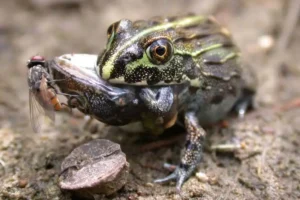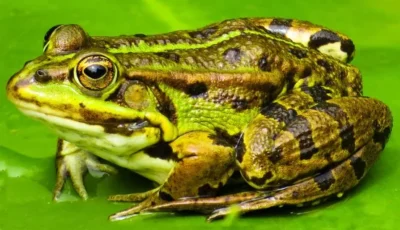Frogs are fascinating creatures with diverse diets that vary based on their species and environment. A common question among nature enthusiasts and pet owners alike is, “Do frogs eat slugs?” Given their natural role as insectivores, it’s no surprise that many people wonder if slugs—often found in damp, shady areas—are on a frog’s menu.
In this article, we’ll dive into the dietary habits of frogs and explore the role slugs play in their diet. Whether you’re a curious naturalist or a frog enthusiast, understanding what these amphibians munch on can offer valuable insights into their behavior and ecosystem. So, do frogs really eat slugs? Let’s find out!
Do Frogs Eat Slugs?

Yes, many types of frogs do eat slugs. Frogs are generally insectivores, but their diet can include a variety of small invertebrates, including slugs. The exact diet can vary depending on the frog species and its environment.
In addition, frogs are carnivorous and have a diet that mainly consists of small invertebrates. Their diet can vary depending on their size, species, and habitat. Here’s a breakdown of why frogs eat slugs and how it fits into their overall feeding habits:
Why Frogs Eat Slugs
- Nutritional Value: Slugs are a good source of protein and other nutrients that frogs need. They provide essential vitamins and minerals, making them a suitable food source.
- Availability: In many environments, slugs are abundant and relatively easy for frogs to catch. They often live in moist or damp areas that are also ideal habitats for frogs.
- Feeding Behavior: Frogs use their sticky, extendable tongues to catch prey. Slugs move slowly, making them an easier target for frogs compared to more agile insects.
How Frogs Catch Slugs
- Camouflage and Ambush: Frogs often wait quietly in their habitats, blending in with their surroundings. When a slug comes close, the frog uses its long, sticky tongue to snatch it.
- Swallowing: Once caught, the frog swallows the slug whole. Frogs don’t chew their food; instead, they rely on their digestive system to break down the prey.
Varied Diet
Different frog species have different dietary preferences:
- Small Frogs: They may primarily eat insects like flies, ants, and beetles but might also consume small slugs if available.
- Larger Frogs: They have a more varied diet and may include larger prey items like slugs, snails, and even small vertebrates.
Impact on Ecosystem
Frogs play a role in controlling slug populations in their ecosystems. By preying on slugs, frogs help balance the ecosystem and prevent overpopulation of these invertebrates.
Overall, slugs are just one part of a frog’s diverse diet, which helps them thrive in various habitats.
Benefits of Slugs in Frogs’ Diet
Slugs can be a beneficial part of a frog’s diet for several reasons:
- Nutrient-Rich: Slugs are packed with essential nutrients that frogs need, such as proteins, vitamins, and minerals. This helps ensure a balanced diet and supports overall health.
- Variety: Including slugs in a frog’s diet adds variety, which can be important for preventing dietary boredom and ensuring the frog receives a range of nutrients.
- Hydration: Slugs have a high water content, which can help keep frogs hydrated. Proper hydration is crucial for a frog’s skin health and overall bodily functions.
- Digestive Health: The rough texture of slugs can aid in the natural wear and tear of a frog’s teeth and digestive tract, helping to keep their digestive system functioning smoothly.
- Enrichment: Hunting and consuming slugs can provide mental stimulation for frogs. This kind of enrichment can help mimic their natural behaviors and contribute to their well-being.
- Calcium: Some slugs contain a significant amount of calcium, which is important for maintaining strong bones and healthy metabolic functions in frogs.
When feeding slugs to frogs, it’s important to ensure that the slugs are free from pesticides or contaminants that could harm the frog.
Frog Species That Eat Slugs

Several frog species eat slugs as part of their diet. Here are a few examples:
- American Bullfrog (Rana catesbeiana): These large frogs are known to eat a variety of prey, including slugs, insects, and even small vertebrates.
- European Common Frog (Rana temporaria): This species often consumes slugs, along with other invertebrates like worms and insects.
- Pacman Frog (Ceratophrys spp.): Known for their voracious appetites, Pacman frogs will eat slugs, as well as insects and small mammals.
- Leopard Frog (Lithobates pipiens): Slugs are a part of the diet of Leopard frogs, especially in environments where these creatures are abundant.
- Tree Frogs (Hyla spp.): Some tree frog species, such as the Green Tree Frog (Hyla cinerea), may eat slugs in addition to insects.
- Gray Tree Frog (Hyla versicolor): This species also feeds on slugs, along with various other small invertebrates.
These frogs benefit from the nutritional content and variety that slugs provide. If you’re considering feeding slugs to frogs in captivity, make sure to offer them in moderation and ensure they are free of pesticides and contaminants.
Impact of Slugs on Frogs
Slugs might not seem like a significant part of a frog’s diet, but they actually play a more important role than you might think. For many frog species, slugs are a valuable food source, offering a range of benefits that contribute to their health and well-being. However, like any dietary component, slugs also come with potential risks that can impact frogs in various ways. Understanding both the positive and negative effects can help us appreciate the complexity of frogs‘ dietary needs and the importance of their natural food sources.
Positive Impacts:
- Nutritional Boost: Slugs are rich in essential nutrients like proteins, vitamins, and minerals. For frogs, these nutrients support overall health, growth, and vitality. The protein content helps in muscle development and maintenance, while vitamins and minerals contribute to various bodily functions.
- Hydration: Slugs have a high water content, which is beneficial for frogs. Proper hydration is crucial for frogs, especially since they have permeable skin that relies on external moisture. Consuming slugs can help maintain the necessary hydration levels.
- Dietary Variety: Offering a variety of prey, including slugs, ensures that frogs receive a balanced diet. This variety helps prevent nutritional deficiencies and encourages natural foraging behaviors, which is important for their mental stimulation and overall well-being.
Negative Impacts:
- Parasites and Disease: One of the primary concerns with feeding frogs slugs is the potential for parasites or diseases. Slugs can carry parasites that might be harmful if ingested by frogs, especially if the slugs come from polluted or contaminated areas.
- Toxicity Risks: Some slugs produce mucus or toxins as a defense mechanism. If ingested in large amounts or if the frog is particularly sensitive, these substances could potentially cause harm or lead to digestive issues.
- Digestive Challenges: Although slugs are a natural part of some frogs’ diets, consuming them in excess or if they are not the right size can lead to digestive problems. It’s important to ensure that slugs are appropriately sized and not the sole food source.
While slugs can be a nutritious and hydrating part of a frog’s diet, it’s essential to be mindful of potential risks. Ensuring that slugs are clean and free of contaminants, and offering them in appropriate amounts, can help maximize their benefits while minimizing any negative impacts on frogs.
How to Provide Slugs for Captive Frogs

Conclusion
Do Frogs Eat Slugs? Yes, frogs do eat slugs! Slugs can be a nutritious part of a frog’s diet, providing essential proteins, vitamins, and hydration. They also offer dietary variety, which helps keep frogs healthy and engaged.
However, it’s important to ensure that slugs are sourced from clean environments and are free of contaminants to avoid any health risks. By properly preparing and feeding slugs, you can support your frog’s well-being while adding a bit of natural enrichment to their diet.

